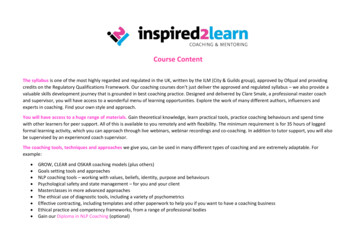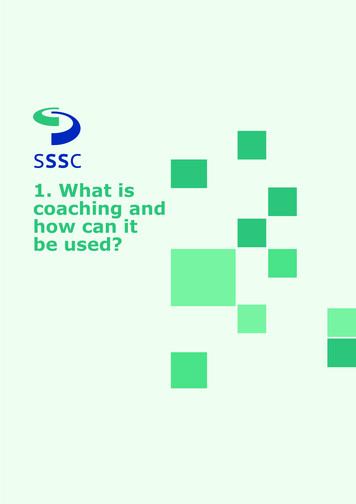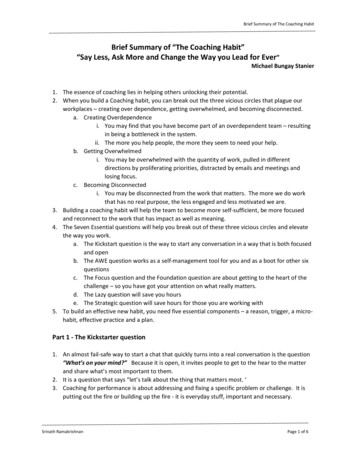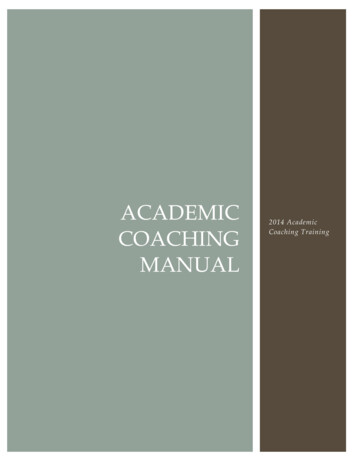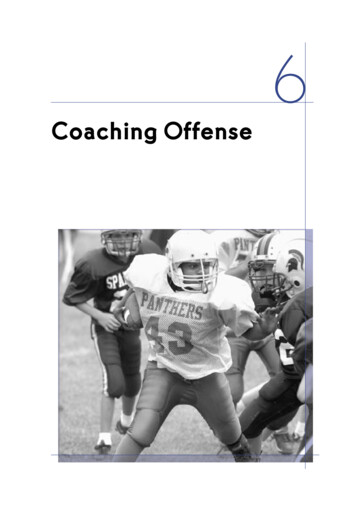
Transcription
Coaching Offense6
62 Coaching Youth FootballThis chapter focuses on the offensive techniques and tactics your playersneed to perform effectively in youth football games. Remember to use theIDEA approach to teaching skills: introduce, demonstrate, and explain theskill, and attend to players as they practice the skill (see page 50 in chapter 5).This chapter also ties directly to the season plans in chapter 10, describing thetechnical skills and the team tactics that you’ll teach at the practices outlinedthere. If you aren’t familiar with football skills, rent or purchase a video soyou can see the skills performed correctly. Also, the Coaching Youth FootballOnline Course offered by the American Sport Education Program (ASEP) andUSA Football can help you further understand these skills. (You can take thiscourse by going to www.asep.com/coachingyouthfootball.)Because the information in this book is limited to football basics, you willneed to advance your knowledge as a coach as your players advance in theirskills. You can do this by learning from your experiences, watching and talkingwith more experienced coaches, and studying resources on advanced skills.Offensive Technical SkillsThe offensive technical skills you will teach your players are assuming a properstance, blocking, running the ball, playing quarterback, receiving, and centeringthe ball. Mastering these techniques will allow your offensive players to betterexecute your offensive tactics—or plays—during the game. These basic skillsserve as the foundation for playing football well at all levels. Football playerspractice these techniques at every practice from youth football to the pros.StanceThe stance is the proper alignment of a player’s body at the start of each play.Following is a description of the stances you should teach players at eachoffensive position.Coaching TipBeginners may feel uncomfortablein this stance and may adjust theirfeet so that one foot is way behindthe other. When you see this, askthem to bring the back foot forward so that it is no more offsetthan toe to instep. A more evenfoot alignment allows them to stepeasily with either foot.Offensive LineWhen teaching your offensive linemen theirstance, start with a four-point stance, as shownin figure 6.1, then move to a three-point stanceas needed. To assume a four-point stance, coachthe linemen to do the following: Stand with feet shoulder-width apart withweight balanced evenly on both feet andtoes aligned. Bend the knees and rest a forearm on theinside of each thigh.
Coaching Offense Reach straight out with bothhands slightly in front of theshoulders. Keep the back straight, head up,and shoulders even.This stance is used for straightahead blocking or blocking to oneside or the other. It forms a goodfoundation for adjustments to athree-point stance.Once offensive linemen are comfortable with a four-point stance,instruct them to lift one hand andadjust the position of the feet slightlyinto a three-point stance (see figure6.2). Use these points to teach theoffensive linemen to assume a threepoint stance:Figure 6.1 Proper four-point stance for offensivelinemen. Place the feet shoulder-width apart, in a heel–instep relationship, withthe dominant foot back. Put very little weight on the down hand to allow for quick forward,backward, and lateral movement. Place the left arm loosely across the left thigh. Keep the back straight, with thehead up to see defenders acrossthe line of scrimmage. This position is the strongest and safestfor the back and neck.Check to see that player’s shouldersand back are level. If the shoulders arecocked, the down hand is usually inthe center of the blocker’s body andneeds to be moved more to the outside of the blocker’s shoulder. Whenthe back is angled, the blocker needsto bring the rear end up and decreasethe angle of flex in the legs.Figure 6.2 Proper three-point stance for offensivelinemen.63
64 Coaching Youth FootballReceiversReceivers use two basic types of stances. Thefirst stance used by wide receivers is a twopoint, or upright, stance (see figure 6.3). Itsadvantages are that receivers can get off theline of scrimmage without being held up andthat they are in immediate position to receivequick passes. To assume a two-point stance,receivers should do the following:Figure 6.3 Proper two-point stance forreceivers.Coaching TipCheck to make sure that receiversmove forward on the snap and don’tstep back to start. They should rollover the front foot and step acrossthe line of scrimmage with the backfoot. Place the feet shoulder-width apart, ina heel–toe relationship, with the footclosest to the football back slightlymore than the other. Bend the knees in a comfortable position. Keep weight on the balls of the feetwith a majority of weight on the frontfoot. Keep the back straight, leaning forwardslightly. Square the shoulders to the line ofscrimmage. Hold the arms in a comfortable position. Turn the head in to the center of thefield so that the player can check hisalignment and see the ball when it issnapped.The second stance is a three-point stance, in which receivers distribute theirweight evenly, with their heads up and eyes focused either directly downfieldor on the football (see figure 6.4). The feet are staggered, which allows goodexplosion from the line of scrimmage. To assume the three-point stance,receivers should do the following: Place the feet shoulder-width apart, in a heel–toe relationship, with thefoot closest to the football staggered in a comfortable sprinter’s position. Point knees and toes straight ahead. Keep the back straight, parallel to the ground, and head up looking intothe ball.Make sure that receivers in a three-point stance drive forward and don’t riseup as they come out of their stance to release from the line; check to see thatthe majority of their weight is on the down hand and front foot.
Coaching Offense65Figure 6.4 Proper three-point stance for receivers.CenterTo help young players get in proper position to make the snap to the quarterback,have centers assume a four-point stanceand then lift up their snapping hand toplace the ball on the ground where theycan easily grasp it (see figure 6.5). Later, ifthey are in the position correctly, they canprogress to a three-point stance with thenonsnapping hand and forearm resting onthe thigh. To assume a four-point stance,centers should do the following: Start in an upright stance. Position the feet shoulder-widthapart with the toe of the foot on theside of the snapping hand even with Figure 6.5 Proper four-point stance for centers.the instep of the other foot. Bend at the knees until the forearms rest comfortably on the thighs. Reach straight out with both hands so that they are on the ground slightlyin front of the shoulder pads. Lift the snapping hand and place the ball in position. The ball shouldbe placed with the laces to the outside and rotated slightly toward theground. Grasp the front half of the ball with the fingers over the laces and prepare to lift and turn the ball sideways so that the quarterback can takethe snap.
66 Coaching Youth FootballMake certain that centers have their back straight and shoulders even beforethe snap. They should keep the ball even with the shoulder pad on the sideof the snapping hand.QuarterbackA quarterback’s stance must be poised and relaxed, reflecting confidence. Thequarterback’s feet should be comfortably spread, approximately shoulderwidth apart and as close to the center’s feet as possible. Quarterbacks shouldbend their knees slightly and drop theirhips while remaining as tall over theCoaching Tipcenter as possible. It is the quarterbacks’Beginning quarterbacks often bend atresponsibility to adjust the height of theirthe waist and position their feet too farstance to fit each center. Quarterbacks’from the center’s feet. When you seeshoulders should be parallel to the linethis, move them closer to the centerof scrimmage, their heads up to check theposition of the defense. See figure 6.6 forand instruct them to bend their kneesan example of a proper quarterback’sso that they can reach under the centerstance.to take the snap.Figure 6.6 Proper stance for quarterbacks.
Coaching Offense67Running BacksThe most common stance for halfbacks and fullbacks is a two-point stance(see figure 6.7). In this position running backs are in an upright stance withthe head up, which allows them to see thequarterback and the offensive line. PlayersCoaching Tipat these positions must accelerate quicklyBe sure that running backs move eitherfrom their backfield spot. Before the ballforward or laterally on the snap, basedis snapped, running backs should do theon the play called in the huddle. Iffollowing:they step back to get started, adjust Stand with feet about shouldertheir weight on the down hand so thatwidth apart and weight on the ballsthey can move easily in any direction.of the feet.Stepping back usually occurs when Keep feet nearly parallel to allow arunning backs do not anticipate wherequick burst in any direction.they should move on the snap. Moving Bend knees slightly and place handsthe hand back a few inches creates aon the knees.balanced stance with the weight on the Keep the head up and eyes lookingballs of both feet.ahead.If your running backs use the four- or three-point stance, teach them thesame technique for getting into their stance that you teach the offensive lineplayers.Figure 6.7 Proper two-point stance for running backs.
68 Coaching Youth FootballBlockingBlocking is the cornerstone of all successful offensive teams. Teams use blocking to move a defensive player out of the area where they want to run thefootball and to keep defensive line players from tackling the quarterback.Offensive line players block in some manner on every play. Running backsblock when they are not carrying the football, and wide receivers block whenthey are not catching the football. You can start by teaching your footballplayers basic blocks, blocks that are critical for a successful youth footballprogram. Then, as your team becomes more experienced you may want toadd more advanced blocks.Basic BlocksBasic blocks allow a diverse offensive attack and are the easiest for you to teachand your players to learn. Therefore, it is important that your team masters thebasic blocks used in youth football. These include the drive block, the hookblock, the angle block, and the cross block.Drive Block The drive block is a one-on-one block used most often when adefensive line player lined up directly over an offensive player must be movedfor the play to succeed (see figure 6.8). When teaching your players the driveblock, emphasize these points:Figure 6.8 Drive block. Explode from the stance withthe foot closest to the opponent and drive the hips forward on the third and fourthsteps through the block. Start with short, choppy stepsand keep the feet moving. Step with the foot on the sideof the shoulder they are usingto block. Deliver the block from a widebase and keep the head up andshoulders square. Anticipate the forward movement of the defensive player. Keep the head on the side ofthe opponent toward the holeand make first contact with theopposite shoulder pad. Come off low and get underthe pads of the defensive linemen.
Coaching Offense As the pad makes contact, punch handsinto the opponent to establish momentum and deliver the blow on impact withthe hands or forearms, not the head. Follow through with short, choppysteps, turning the opponent away fromthe hole.If blockers are pushed to one side and falloff their block, make sure that they have a widebase and have not narrowed the split betweentheir feet as they make contact with the defensive player.69Coaching TipOffensive line blockers shoulddrive the palm of the inside handdirectly into the defensive player’schest as they take their secondstep. This will stop the forwardmovement of the defensive playerand allow the offensive blocker toposition the body to the outside.Drive-Blocking Drill Offensive linemen (OL) act as blockers and line up directly in front of defensivelinemen (DL) as shown in the diagram. The coach tells the OL which shoulderto use for the block. OL drive the DL straight back off the line using their leftshoulders, arms, and hands. OL drive the DL behind the line for two or threesteps until the whistle is blown. Repeat drill using the opposite shoulder.Hook Block Use the hook block when blocking a defensive player locatedon the blocker’s outside shoulder and running the ball to the outside of theblock. The blocker seals off the opposing end so that the running back can run around the end to the outside. The blocker takes a short lateral step with theoutside foot (see figure 6.9a), makes contact with the second step (see figure6.9b), and swings around to contain the rusher (see figure 6.9c). The blockerhits the defender at or slightly above waist level and keeps the point of contact
70 Coaching Youth Footballto the side on which the sweep is being run. When teaching your players thehook block, emphasize these points: Remain low. Step laterally with the foot opposite the side of the shoulder used toblock. The first lateral step should be short and quick. Come off low and get under the pads of the defensive lineman. Take the second step directly toward the center of the defensive player’schest, driving the palm of the hand directly into the chest of the defensive lineman. The other hand should drive up and under the shoulderpad of the defensive lineman. Position the body so the defensive player cannot move to the outside.abcFigure 6.9 (a-c) Hook block.
Coaching OffenseHook-Blocking Drill Offensive linemen (OL) act as blockers and line up on the inside shoulder ofthe defensive linemen (DL) as shown in the diagram. The coach tells the OLwhich shoulder to use for the block. The OL keep the DL from working to theoutside by driving them back with their far shoulders, arms, and hands untilthe whistle is blown. Repeat drill using the opposite shoulder.Angle Block The angle block is used to block a defensive player located onthe blocker’s inside shoulder, the inside gap, or in front of the offensive lineman to the inside. The blocker takes a short directional step to the inside andin front of where the defensive player lined up as shown in figure 6.10. Whenteaching players the angle block, emphasize these points: Anticipate the defensive player’s forward movement. Explode off of the outside foot (see figure 6.10a) and make contact withthe outside shoulder pad into the side of the defensive player (see figure6.10b).aFigure 6.10 (a-b) Angle block.b71
72 Coaching Youth Football Keep the head in front of the defensive man, cutting off penetration. Drive the defensive player down the line.When blockers fail to get their heads in front, adjust the angle of the firststep so that it is in front of the defensive player’s alignment. This adjustmentputs blockers in the proper position to stop the defensive player’s movementacross the line of scrimmage.Angle-Blocking Drill Offensive linemen (OL) act as blockers and line up in front of defensive linemen (DL) as shown in the diagram. The coach tells the OL which shoulder touse for the block. OL keep the DL from penetrating down the line by drivingthem back and blocking with the shoulder until the whistle is blown. OLshould try to get their heads in front of the DL. Repeat drill using the oppositeshoulder.Cross Block The cross block can be used to create an element of surprise, to adjust for a mismatch at the line of scrimmage, or to block against a defensivealignment that is difficult to block straight on. In this block, two adjacent players work together to block two defensive players. When both defensive playersare on the line of scrimmage, the outside blocker will usually go first using anangle block. When one defensive player is on the line and the other is linedup off the line (in a linebacker position) (see figure 6.11a), the player blockingthe defensive player on the line will go first.The second player on the cross block needsCoaching Tipto take a short drop step with the foot on theHave players practice blockingside of the block (see figure 6.11b), allow theagainst air, handheld shields, orfirst blocker to move, and then staying low,lightweight standup blocking bagsdrive into the assigned defensive player (seeto see just how fast they can executefigure 6.11c). Blocking form and execution arethe cross block. Speed in executingthe same except for the timing between theblockers. Cross blocks can be performed bythe block gives the offensive linementeammates who line up next to each other—athe opportunity to move into theircenter and guard, a guard and tackle, a tackleblock before the defensive player hasand tight end. This is a bang-bang play; timinga chance to react.and explosive power are the keys.
Coaching OffenseabcFigure 6.11 (a-c) Cross block.When you see the timing between the two blockers is off, make sure thatthe second blocker is not waiting on the first to get all the way into his blockbefore starting to move to his defensive player. The second blocker shouldstep back and then drive to his block at the same time the other player movesinto his block.73
74Coaching Youth FootballCross-Blocking Drill Players divide into groups of four with two offensive linemen (OL) who act asblockers and two defensive linemen (DL) as shown in the diagram. The coachtells the OL which shoulder to use for the block. The outside OL blocks first,and as the first OL is blocking, the second OL steps back with his first stepto provide room for the first blocker to clear. The OL should separate the twoDL by opening a running lane. Both OL should use their shoulders to blockand get their heads in front of the defensive player. The OL will drive until thewhistle is blown. Repeat drill using the opposite shoulder.Advanced BlocksOnce your teamhas mastered the basic blocks, you can begin to teach them more advanced blocking skills. Advanced blocks require a great deal of coordination, and the two offensive blockers must work as one unit. This coordination takes time to practice and should be introduced after the basic blockshave been mastered. The advanced blocks include the double-team block, thezone block, the downfield block, and the pass protection block.Double-Team Block The double-team block should be used when youneed two adjacent blockers working together on one defensive player. Whenthe blockers execute the block correctly, it becomes one of the offense’s mostpowerful blocks. The blockers move simultaneously: the inside blocker usinga drive block and the outside blocker using an angle block.The blockers should drive the defensive player down and off the line ofscrimmage. The inside blocker should step with the outside foot directly atthe midsection of the defensive player and hit with the outside shoulder pad.The outside blocker should step down with the inside foot and, on the secondstep, drive the outside shoulder pad into theside of the defensive player.Coaching TipWhen contact is made, both blockersIf the defensive player is able to splitshould bring their hips together (insidethe two blockers, make certain thatblocker’s outside hip to outside blocker’sthe blockers bring their hips togetherinside hip) to provide a combined pushas they work to drive the defensiveagainst the defensive player. See figure 6.12for an example of the double-team block.player off the line.
Coaching OffenseFigure 6.12 Double-team block.Double Team Blocking Drill Players divide into groups of three with two offensive linemen (OL) who act asblockers and one defensive lineman (DL) as shown in the diagram. The insideOL uses the outside shoulder, and the outside OL uses the inside shoulder tomake the block so that they can come together and generate as much poweras possible against the DL. The OL drive until the whistle is blown. Repeat thedrill using the opposite shoulders.Zone Block The zone block is a combination block using two offensiveplayers against two defensive players.It is most often used against a defen sive lineman and a linebacker who may or may not be stunting. The zoneblock is very difficult to teach and should be added to your team’s blockingscheme only after the previous blocks have been mastered. This blockingscheme requires that the two blockers read the defensive player’s movementtogether. It is usually used against a defense where the outside blocker has adefensive lineman lined up in front of him and the adjacent inside blockerhas a linebacker lined up in front of him.75
76 Coaching Youth FootballWith the ball being run to the outside, on thesnap, both blockers move together. Both playersshould step laterally with the outside foot. Theoutside player should use a hook block techniqueand stop the charge of the defensive player withthe second step. The inside player should see thelinebacker and determine if he is moving to theoutside behind the defensive lineman or chargingstraight ahead (see figure 6.13, a and b).If the linebacker is moving to the outside, theinside blocker should continue into the defensivelineman and use a hook block technique. The outside blocker in this caseshould continue to the outside and move up the field to block the linebackerwith a drive block. When the linebacker charges straight ahead, the insideblocker should adjust his path to be in position to drive-block the linebackerwith the inside shoulder. The outside blocker continues to hook-block thedefensive lineman.Coaching TipWhen the defensive linemanpenetrates across the line, goback and make certain that thetwo blockers are giving firstpriority to blocking this playerbefore either one moves off topick up the linebacker.abFigure 6.13 (a-b) Zone block.
Coaching OffenseZone-Blocking Drill Players divide into groups of four with two offensive linemen (OL), who actas blockers, one defensive lineman (DL), and one linebacker (LB) as shownin the diagram. The two OL block the DL. To start the block, the OL that isdirectly in front of the DL uses the inside shoulder, arm, and hand, and thesecond blocker uses the shoulder, arm, and hand nearest the DL. Based onthe LB and DL movement, one OL comes off the DL block to ensure that boththe LB and the DL are blocked effectively. Downfield BlockAlthough mostblocks occur near the line of scrimmage, blocking is needed in othersituations. Receivers often need toblock for their teammates in orderto create space for them to run or tohelp them avoid a tackle. The downfield block is used in these situations.When using the downfield block,make sure the block is made abovethe defender’s waist to avoid injury.In a downfield block when theball carrier is directly behind theblockers, they should use a run–block technique, which is a blockmade past the line of scrimmage ona defender who is trying to reach theball carrier. In this situation, they blockthe defender at full or three-quarterspeed by attacking aggressively withthe forearms and shoulders (seefigure 6.14). When blocking a Figure 6.14 Downfield block.77
78 Coaching Youth Footballdefensive player who is backing up, blockersshould run straight through the block. Doing socreates space for the ball carrier, allowing him topass the defender. If the defensive player is attacking up the field, blockers should block the playeraway from the ball carrier’s path or in the directionhe wants to go and let the defensive back cut offthe block. Blockers should shorten their stride and widen their base as theynear the defensive player.If blockers have difficulty executing the downfield block, and the defensiveplayer is avoiding the block, make certain that blockers are running undercontrol with a shortened stride and are not leaning forward at the waist. Controlled body position and movement allow them to adjust their path at thelast moment and make contact with the defensive player.Coaching TipBlockers should focus on andaim for a point 5 yards past thedefensive player so that theylearn to run through the block.Downfield-Blocking Drill Players divide into groups of three with one wide receiver (WR), who acts asa blocker, one running back (RB), and one defensive back (DB) as shown inthe diagram. The WR blocks the DB to allow the RB to run past the DB. TheWR and DB start 5 yards apart. On the whistle, the WR charges toward theDB and aggressively blocks the DB with his forearms and shoulders while theDB tries to get through the block and tackle the RB.Pass Protection Block The pass protection block keeps the defender fromgetting to the quarterback before the quarterback can throw the football. Theinitial move and setup by an offensive lineman is extremely important in passblocking. The offensiveline playermust set up quickly, stepping to the inside with the inside foot first, and must push up into a two-point stance with thedown hand. The movement projects the offensive line player into a position
Coaching Offense79with the head up, eyes open wide, back straight,Coaching Tiprear end down, and hand and arms up. TheOn defenses that allow a wideplayer should position the feet shoulder-widthupfield rush by the defensiveapart with knees bent so that the body weight isplayer, offensive tackles mustmaintained over the feet (see figure 6.15a). Thisallows backward or lateral movement in a splitlearn that they may have to turnsecond, as shown in figure 6.15b. Elbows shouldtoward the sideline and forcebe positioned into the side, and forearms andan outside rushing defensivehands should be brought up with the palms openplayer up the field past thein front of the chest.quarterback’s position.The depth the pass blocker sets up off the line ofscrimmage varies with the pass action called andthe opponent’s defensive front alignment and charge. Offensive linemen who arepass-blocking must position themselves between the quarterback and the defensive pass rusher. They can do this by backing off the line of scrimmage quicklyafter the snap. Tell your offensive line players that they should never be beaten totheir inside. Offensive running backs who are pass-blocking must also positionthemselves between the quarterback and the defensive rusher, although they willbe setting up a few yards deep in the backfield before the snap.aFigure 6.15 (a-b) Pass protection block.b
Pass Protection TipsPass protection blocking is different from other blocks. Pass protection isdifferent because the offensive player must sit and wait for the defensiveplayer, rather than firing out aggressively on the snap of the ball. Followingare a few helpful tips that coaches can use when teaching this block.PunchIt takes good timing to deliver a blow to stop the charge of the defensiveline player. The blocker must let the defensive line player get as close assix inches away from him and then deliver the blow to stop the charge.The blocker must strive to deliver a blow, step back from the defensiveline player, and recoil. The blocker must deliver the punch with the elbowslocked, keeping them held close to the rib cage. When delivering the punch,the blocker must also roll the wrists to achieve power. The blockers’ handsand arms must stay within the planes of the shoulders.When blockers lunge at the defensive player, make certain that theykeep their back straight and do not bend forward at the waist, putting theirhead and shoulders in front of their hips. The forward lean makes it easierfor the defensive player to move around the offensive blocker to reach thequarterback.PatiencePatience quite possibly may be the hardest thing to teach offensive lineplayers. Offensive line players must learn to be the protector, not theaggressor. They must keep their legs under them and must always remainin a good blocking position even after delivering the punch. Instructoffensive line players to keep their rear ends down and their knees bentat all times.FootworkThe most important skill for offensive line players is the ability to movetheir feet. The correct foot movement is a shuffle, with the player keepingone foot always in contact with the ground. Offensive linemen shouldnever cross their feet and should always keep their bodies between thedefensive player and the quarterback with their backs always to thequarterback.80
Coaching Offense81Pass Protection—Blocking Drill Offensive linemen (OL) act as blockers and line up directly in front of thedefensive linemen (DL) as shown in the diagram. A cone or flag denotingthe quarterback (QB) is positioned behind the OL. The coach moves downthe line, calling out the snap count to each group. On the snap count fromthe coach, the DL rushes straight at the OL at half speed and does not takea side. The OL moves off the line and punches out with the arms and handsto block the approaching DL. The OL attempts to get into a position betweenthe DL and the QB. The OL drives until the whistle is blown. Repeat the drillby resetting to hit out again.A variation of this drill requires that it is performed the same as above, butthe two outside OL face toward the sideline and push the DL up the field,wide of the QB. The three inside OL stay to the inside and in front of the DL,slow the charge, and force them wide of the QB.Running the BallRunning the ball involves many skills, including getting the handoff, carryingthe ball, using blockers, and being the blocker. If much of your offense consists of running rather than passing plays, then developing the
68 Coaching Youth Football Coaching Offense 69 Blocking Blocking is the cornerstone of all successful offensive teams. Teams use block-ing to move a defensive player out of the area where they want to run the football and to keep defensive line players from tackling the quarterback. O



